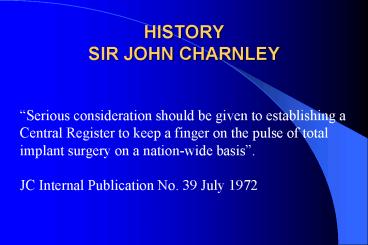HISTORY SIR JOHN CHARNLEY - PowerPoint PPT Presentation
1 / 20
Title:
HISTORY SIR JOHN CHARNLEY
Description:
Patient Reported Outcome Measures (PROMS) TOTAL KNEE REPLACEMENT BRANDS. 65 Total Condylar ... The effect of variations in pain on patient satisfaction is ... – PowerPoint PPT presentation
Number of Views:292
Avg rating:3.0/5.0
Title: HISTORY SIR JOHN CHARNLEY
1
HISTORY SIR JOHN CHARNLEY
Serious consideration should be given to
establishing a Central Register to keep a finger
on the pulse of total implant surgery on a
nation-wide basis. JC Internal Publication No.
39 July 1972
2
HISTORY
- 1990 - Trent Region Arthroplasty Register
- 2002 decision to establish National Joint
Registry - following 3-M Capital Hip Problem
- April 2003 National Joint Registry (England and
Wales) commenced data collection
3
AIMS OF NJR
- Comparative audit of hospitals and prostheses
- Monitor new prostheses
- Major research database
- Identify patients with poorly performing
prostheses
4
NATIONAL JOINT REGISTRY (NJR)
- Run by private sector company
- AEA Technology 2003 2006
- Northgate Information Solution (NIS) 2006 - 2009
- Overseen by NJR Steering Committee
- Regional Clinical Coordinators
- Financed by levy on prostheses
5
NATIONAL JOINT REGISTRY (NJR)
- Minimum Dataset collected at time of surgery
- Electronic transfer to NIS
- Organisation and analysis of data by NIS and
Royal College of Surgeons Clinical Effectiveness
Unit (RCS CEU)
6
MINIMUM DATA-SET
- Patient demographics
- ASA grade
- Orthopaedic unit
- Date of surgery
- Consultant
- Name and grade of lead surgeon
- Surgical technique
- Prosthesis
- Thromboprophylaxis
7
NATIONAL JOINT REGISTRY
- 202 NHS hospitals/TCs
- 11 ISTCs
- 159 IHs
- gt 600,000 hip and knee joint replacements
registered
8
NATIONAL JOINT REGISTRY
- 39,000 registrations per quarter
- Compliance gt 80
- Patient consent 88
- Linkability 83 (20 in 03/04)
9
MEASURABLE OUTCOMES (PRESENT)
- Mortality (0.6 at 3 months)
- Revision of joint replacment
10
MEASURABLE OUTCOMES (FUTURE)
- Infection
- Dislocation
- Patient Reported Outcome Measures (PROMS)
11
TOTAL KNEE REPLACEMENT BRANDS
- 65 Total Condylar
- 15 Uni-condylar
- 9 Patello-Femoral
- 14 Hinged
12
PRIMARY TOTAL KNEE REPLACEMENT (2007)
- Cemented 83
- Uncemented 6
- Unicondylar 8 (50 MIS)
- Patello-Femoral 1
13
3 YEAR TKR REVISION RATES (95 C.I.)
- Cemented 1.2 (1.1 1.3)
- Uncemented 1.5 (1.2 1.9)
- Hybrid 1.7 (1.0 2.8)
- Unicondylar 2.0 (1.5 2.7)
14
3 YEAR TKR REVISION RATES (95 C.I.)
- PFC Sigma 1.1 (1.0 1.3)
- AGC 1.1 (0.9 1.4)
- Nexgen 0.8 (0.6 1.1)
- Scorpio 1.2 (0.9 1.6)
15
MULTIVARIATE ANALYSIS (HAZARD RATIO)
- Age, sex, physical status, provider type
- Risk of revision of Unicondylar x 1.4 that of
cemented TKR at 3 years
16
ANALYSIS OKS
Mean OKS 25.0 (S.D 10.1) Median OKS 22 (IQR
1731)
- Figure 1 Distribution of OKS in 7230 pts for
whom it could be calculated
17
ANALYSIS SATISFACTION
- Satisfaction questions were completed by 8095
patients - Overall
- - 81.8 were satisfied
- - 11.2 were unsure
- - 7.0 were not satisfied
- The OKS varied according to patient satisfaction
(plt0.001)
18
OKS AND SATISFACTION
Table 1 Breakdown of OKS by satisfaction
status Between group comparison using ANOVA,
plt0.001 between all groups (Bartletts test for
equality of variance pgt0.05)
19
SUMMARY REGRESSION ANALYSIS
- Higher levels of both pain and functional
limitaton, as measured by the OKS, were
associated with lower levels of patient
satisfaction (plt0.001) - The effect of variations in pain on patient
satisfaction is approximately twice the effect of
variations in function
20
SUMMARY REGRESSION ANALYSIS
- Men were more satisfied than women (plt0.05)
- Patients with a diagnosis other than OA were more
often satisfied than those who had surgery for OA
(plt0.05) - We also found evidence that
- Patients with unicondylar replacement were less
likely to be satisfied than patients who
underwent cemented total knee replacement
(p0.002) - People aged 70-80 were more likely to be
satisfied when compared to those aged lt65
(plt0.05) - Patients who were ASA grade 3 were more likely to
be satisfied when compared to those who were ASA
1 (p0.002)

